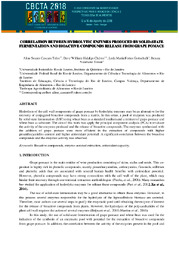Correlation between hydrolytic enzymes produced by solid-state fermentation and bioactive compounds release from grape pomace.
Correlation between hydrolytic enzymes produced by solid-state fermentation and bioactive compounds release from grape pomace.
Author(s): TELES, A. S. C.; CHÁVEZ, D. W. H.; GOTTSCHALK, L. M. F.; TONON, R. V.
Summary: Hydrolysis of the cell wall components of grape pomace by hydrolytic enzymes may be an alternative for the recovery of conjugated bioactive compounds from a matrix. In this sense, a pool of enzymes was produced by solid-state fermentation (SSF) using wheat bran as a standard medium and a mixture of grape pomace and wheat bran as substrate. The aim of this work was apply the principal component analysis (PCA) to evaluate the activity of the enzymes produced and the release of bioactive compounds. The enzymes synthesized with the addition of grape pomace were more efficient in the extraction of compounds with higher proanthocyanidins content and higher antioxidant potential. A significant correlation between the bioactive compounds and the enzymes activity was observed.
Publication year: 2018
Types of publication: Paper in annals and proceedings
Unit: Embrapa Food Technology
Observation
Some of Embrapa's publications are published as ePub files. To read them, use or download one of the following free software options to your computer or mobile device. Android: Google Play Books; IOS: iBooks; Windows and Linux: Calibre.
Access other publications
Access the Agricultural Research Database (BDPA) to consult Embrapa's full library collection and records.
Visit Embrapa Bookstore to purchase books and other publications sold by Embrapa.

